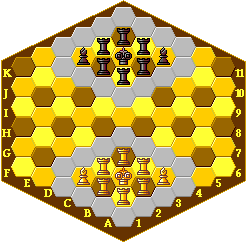King's Color
King's Color is a chess variant, invented in 1976 by Dutch games inventor Christian Freeling. It resembles in several aspects the game Chad, also invented by Freeling, who writes in his description of King's Color:
King's Color is a renegade offspring of the Chad system. It's tactics are shamelessly capricious. Some players however, insist it's great fun. These players obviously have no sense of taste and more likely no sense at all!
Rules
The game is played by two players on a board with hexagonal cells. The diagram below shows the opening setup. The board shows for each player a castle of nine hexes, surrounded by a wall, consisting of the fourteen hexes around the castle (shown in grey).

Material
To play King's Color, it is best to use flat pieces, with the ideogram of a rook on one side, and the ideogram of a bishop on the other.
Play
White begins. Players move, and must move, in turn.
The King is confined to his 3x3 castle. He may go and capture using either the King's move or the Knight's move. (These moves are similar as those of these pieces in e.g., Glinski's Hexagonal Chess.
It's customary to look at the King in terms of the squares it does not cover. In the center it covers the whole castle, on the side he does not cover the square on the opposite side, and in the corner it does not cover the other corner squares.
The rook moves along vertical or oblique files, unhindered by castles and walls.
The bishop moves along diagonals unhindered by castles and walls.
The mutual right of capture exists, and only exists, between an attacking piece on the wall and a defending piece inside the castle. Apart from this situation pieces simply block one another.
This is a crucial rule! For some implications, see Chad.
The King's Color Rule
The other rule that is essential for the game, and the unique element of King's Color is the following:
Pieces on the same bishop domain (or "color") as their own King, are bishops by definition.
Pieces on a bishop domain (or "color") other than their own King, are rooks by definition.
For this rule, note that one can color the squares of a hexagonal chess board by three colors, such that each bishop always stays on squares of the same color. While in the diagram, the walls of the castle are colored grey, they are considered to be colored with one of the three colors given to the other squares; systematically, such that every `diagonal move' goes between squares of the same colors. Thus, this divides the board in three bishop domains.
Implications
As long as one's King remains on the same bishop domain, only rooks may change their role: a rook ending its move on a cell of the same color as its own King, immediately changes into a bishop (which is done by reversing the piece).
If, however, the king moves to a cell of another domain (color), several things happen simultaneously:
- All the player's bishops turn into rooks!
- The player's rooks on the domain the King now occupies, turn into bishops!
Comment
Christian Freeling commented on his game:
Is this crazy or what! On top of that white can give check on his first move. Have fun!
WWW page made by Hans Bodlaender. This is a edited version of a text on King's Color by Christian Freeling. Text and diagram used with permission from Christian Freeling and Mindsports. For more information on this and other games by Christian Freeling, see the Mindsports website, by Christian Freeling and Ed van Zon.
WWW page created: May 6, 1998. Last updated: January 23, 2005.
